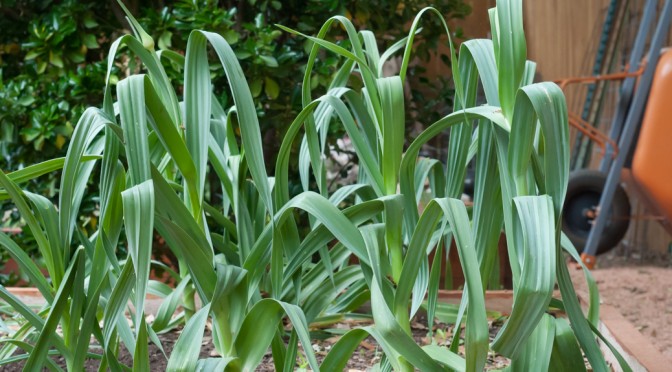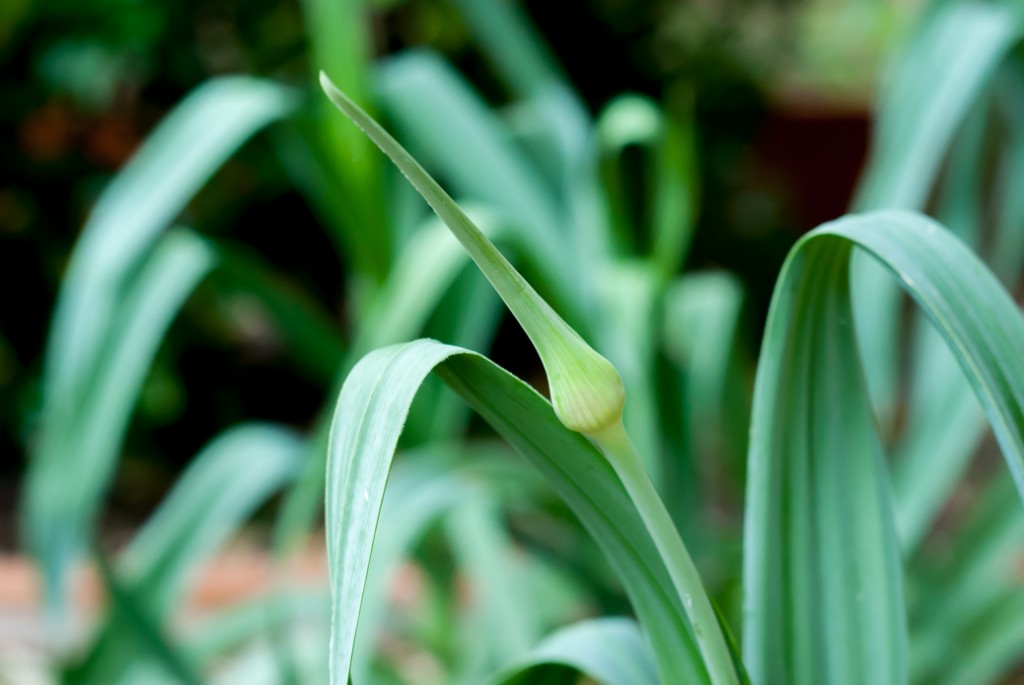Types:
Hardneck – This type of garlic has a firm stalk sticking straight out of the top of the bulb. Hardneck varieties are said to be closest to wild garlic. Having complex flavors, they are often compared to wines as their taste varies with climate and soil composition. This type of garlic also has a shorter shelf-life of only four to six months. Some folks claim that elephant garlic is a hardneck variety, but it is actually a member of the leek family. (Thanks University of Kentucky – College of Agriculture)
Softneck – When you venture to your grocery store, or to the local farmers’ market, softneck garlic is typically what you will find for sale. The flavor of this variety is somewhat milder that that of hardneck garlic. Additionally, the stalks are pliable, thus the name softneck, and makes for easy braiding – when you see a braid of garlic, it is made with softnecks. Softneck garlic can be stored for six to ten months once cured.
Growing Garlic:
Planting – If you purchase seed garlic, you will generally receive several full garlic heads. Make note of which end has the roots – this will be the flat bottom end of the garlic with a circular growth nub. You can also tell by which end is not pointy, once you separate the heads into individual cloves. Over time, I have learned that garlic will grow in just about any type of soil, but some folks claim that it likes slightly acidic soil with a rating of 6-7 pH. It does to better in loose soil, and I generally plant my garlic in compost-heavy beds. Having loose soil will also aid during harvest time. I generally plant garlic in the south in late October or early November, depending upon the weather. Texas A&M states it should be less than 85 degrees. Plant individual cloves with the pointy side up, 4″ – 6″ apart, and about 2″ deep. Considering I only have beds, I line each bed edge containing compatible plants with garlic. If you are fortunate enough to have a plot of land, make your rows at least 18″ apart. Since I use mostly compost for replenishing my soil nutrients, I do not use mulch, as compost is a great natural mulch and it does not rob the soil nutrients by decomposing over time.
Watering and Feeding – Water your newly planted garlic well, and then only water when the soil is mostly dry. If your soil is too moist, your garlic could rot, which is why loose, well-drained soil is a must. Many places will discuss the necessity of keeping your garlic weed-free. I would contend that if you are properly feeding your soil, you will have no weeds, as weeds grow where healthy plants cannot. I have yet to have a weed grow in my garden beds – pecan, oak, and pine tree shoots, yes, but not weeds. Like most garden plants, garlic plants like a balanced fertilizer. I tend to use my soil nutrient mixture and supplement with additional compost as the soil level lowers throughout the growing season. Adding compost every 3-4 months is never a bad idea.
Pruning Scapes – Scapes are the stalks that hardneck garlic will shoot up around late spring. There is a bulb on the end of the scape that some folks believe to be a flower, but it instead just produces mini-bulbs which can be planted to form more garlic – these take considerably longer to grow than from cloves. Although this can be done, pruning scapes about an inch or so above the top plant leaf will concentrate the plant’s energy toward growing the bulb – a better choice in my opinion.
Harvesting and Storage:
Harvesting – Knowing when to harvest garlic is still something that is up for debate. Some folks claim a certain amount of months after planting is good, while other claim to watch for signs from the plants. The important thing about harvesting garlic is that the heads need to be ready for harvesting and storage, meaning they must be matured correctly. Much like reading the health of other garden plants, harvesting garlic is all about reading the leaves. Each leaf constitutes a layer of protective wrapping around the head – count the number of green leaves and you have the number of wrappings around the head. Garlic leaves die from the bottom up and when about half of the plant’s leaves have died off, stop watering. Harvest the plant when there are four (4) green leaves left by loosening the soil with a fork carefully and pulling the garlic out by the base of the stalk. Do not wash off the excess dirt which may be on the bulk, brush it off instead, and do not remove the protective wrappers. Immediately take you garlic inside from sunlight, as leaving newly-harvested garlic in direct sun can cook the heads.
Storage – Once harvested, you can bundle the plants in groups of five (5) to ten (10) and hang them inside, again, away from directly sunlight but in an area which has good air circulation. It will take approximately 3-5 weeks for garlic to cure. You can validate curing by checking to see if the wrappers are dry. Cut the neck and trim the roots and store in a ventilated bag or crate.


